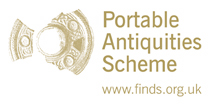File:Bronze Age Gold (FindID 834950-1084833).jpg
Bronze_Age_Gold_(FindID_834950-1084833).jpg (553 × 461 pixels, file size: 33 KB, MIME type: image/jpeg)
Captions
Captions
Summary
[edit]| Bronze Age Gold | |||
|---|---|---|---|
| Photographer |
Somerset County Council, Megan Gard, 2019-12-11 11:09:05 |
||
| Title |
Bronze Age Gold |
||
| Description |
English: Description: A fragment of embossed gold sheet, decorated with circular (repoussé) bosses and pointillé (applied to v-shaped furrows in the sheet). There are two lines of pointillé and two rows of bosses (five complete and two incomplete bosses on one row and five bosses and one incomplete boss on the other row). The fragment has be snipped along three edges, while the forth edge is ragged. Along the ragged edge are several small, intentional perforations. One edge has apparently been folded and unfolded - in antiquity or since discovery. The decorative bosses are all slightly flattened and scuffed. Around them it is possible to identify circles indicative of the stamp/tool used to fashion them (individually).
Dimensions: Length: 26mm; Width: 23mm; Thickness: c.0.2mm; Weight: 1.86g Metal composition: Non-destructive X-ray fluorescence analysis undertaken by the Science department of the British Museum indicated a surface composition of approximately 84-86% gold, 13-15% silver, the rest being copper. See appended report. Discussion: The combination of bosses and pointillé and the v-shaped furrows is a known (but rare) feature of the Early Bronze Age embossed gold tradition dating to the period c.2100-1700 BC (Needham 2000; Needham & Sheridan 2014, 913-14). A hoard of goldwork from Woolaston, Gloucestershire (2013 T805; British Museum accession numbers 2016, 8011.1-8), included gold ornaments decorated with both pointillé, repoussé and with v-shaped furrows (Wilkin 2014), but circular bosses are not included among the decorative motifs. The exact dating of these objects is subject to debate but an early Middle Bronze Age date has been postulated based on morphological similarities (decorative and morphological parallels are not forthcoming). A strip with similar decoration was found at Dún Ailinne, Ireland, which has been dated to the Bronze Age generally (Fischer in Johnston & Wailes [1984] 2007, 112-3). However, the closest parallel for the Rampisham fragment is, in fact, the Mold Gold Cape (British Museum accession number: 1836, 0902.1; Needham 2012), and the second cape fragment identified by Needham (Ibid.). The surface X-ray fluorescence analysis of the Rampisham fragment indicates a high silver content consistent with other objects of the embossed gold tradition, including the Mold Cape and the Lockington Armlets (Needham 2012, Table 2) and with the Woolaston ornaments (2013 T805). Conclusion: Consequently, in terms of age and as the object contains a minimum of 10% precious metal it qualifies as Treasure under the stipulations of the Treasure Act 1996. References: Johnston, Susan A., Bernard Wailes, Pam J. Crabtree, Douglas V. Campana, Ronald Hicks, Katherine Moreau, Elizabeth Hamilton, and G. C. Fisher, 2007, Dún Ailinne: Excavations at an Irish Royal Site, 1968-1975. University of Pennsylvania Press, Needham, S. 2000. 'The development of embossed goldwork in Bronze Age Europe'. The Antiquaries Journal 80, 27-65 Needham, S. 2012. 'Putting capes into context: Mold at the heart of a domain'. In W. Britnell and R. Silvester (eds), Reflections on the Past: Essays in Honour of Frances Lynch. Welshpool: The Cambrian Archaeological Association Needham, S. & Sheridan, A. 2014. Chalcolithic and Early Bronze Age goldwork from Britain: new finds and new perspectives. In H. Meller, R. Risch & E. Pernicka (eds) Metalle der Macht - Frühes Gold und Silber, 903-41. Halle (Saale): Tagungen des Landesmuseum für Vorgeschichte, Band 11/II Wilkin, N. 2014. 'Bundles of joy? A hoard of Bronze Age goldwork from Woolaston, Gloucestershire', PAST (Newsletter of the Prehistoric Society), No. 78, Autumn 2014, 1-2 |
||
| Depicted place | (County of findspot) Dorset | ||
| Date | between 2100 BC and 1700 BC | ||
| Accession number |
FindIdentifier: 834950 |
||
| Credit line |
|
||
| Source |
https://finds.org.uk/database/ajax/download/id/1084833 Catalog: https://finds.org.uk/database/images/image/id/1084833/recordtype/artefacts archive copy at the Wayback Machine Artefact: https://finds.org.uk/database/artefacts/record/id/834950 |
||
| Permission (Reusing this file) |
Attribution License | ||
| Other versions | FindID 834950 has multiple images: 1084832 1084833 search | ||
Licensing
[edit]- You are free:
- to share – to copy, distribute and transmit the work
- to remix – to adapt the work
- Under the following conditions:
- attribution – You must give appropriate credit, provide a link to the license, and indicate if changes were made. You may do so in any reasonable manner, but not in any way that suggests the licensor endorses you or your use.
File history
Click on a date/time to view the file as it appeared at that time.
| Date/Time | Thumbnail | Dimensions | User | Comment | |
|---|---|---|---|---|---|
| current | 12:10, 12 December 2020 |  | 553 × 461 (33 KB) | Fæ (talk | contribs) | Portable Antiquities Scheme, DOR, FindID: 834950-1084833, bronze age, page 1342, batch count 4681 |
You cannot overwrite this file.
File usage on Commons
The following page uses this file:

